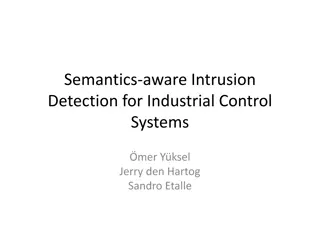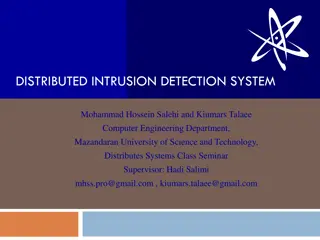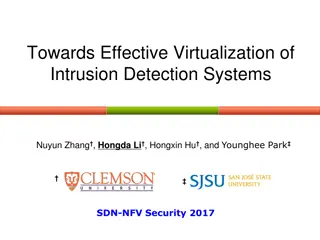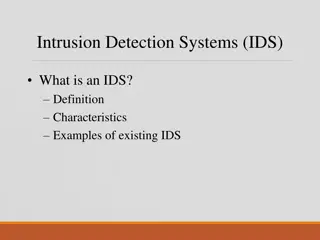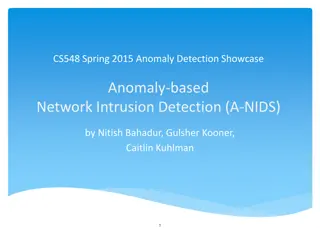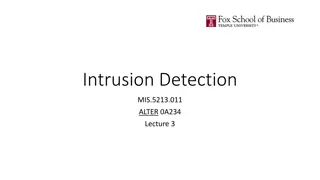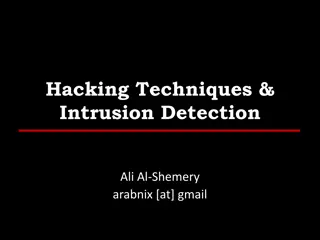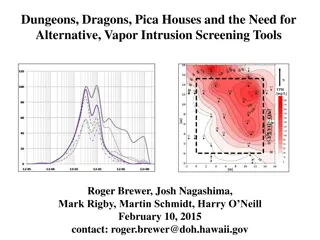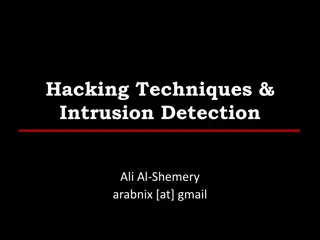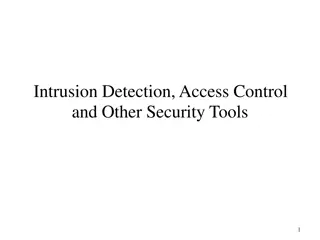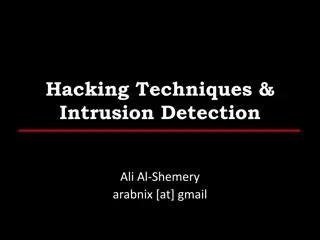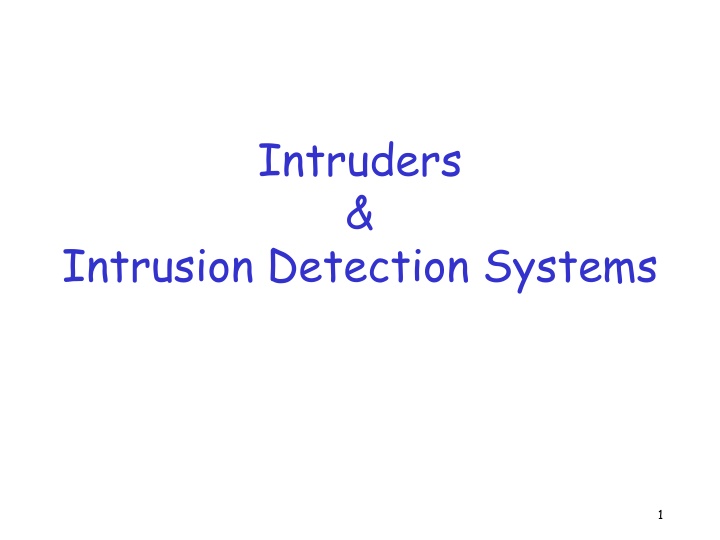
Intruders and Intrusion Detection Systems
Intruders can be classified into three classes: individuals not authorized to access a system, masqueraders, and misfeasors. Examples of intrusions include remote root compromises, password guessing, and unauthorized data access. Intrusion detection systems help counter hacker threats, including criminal hackers who target specific information. Organizations can enhance security by restricting remote logins and staying updated on software patches to address vulnerabilities.
Download Presentation

Please find below an Image/Link to download the presentation.
The content on the website is provided AS IS for your information and personal use only. It may not be sold, licensed, or shared on other websites without obtaining consent from the author. If you encounter any issues during the download, it is possible that the publisher has removed the file from their server.
You are allowed to download the files provided on this website for personal or commercial use, subject to the condition that they are used lawfully. All files are the property of their respective owners.
The content on the website is provided AS IS for your information and personal use only. It may not be sold, licensed, or shared on other websites without obtaining consent from the author.
E N D
Presentation Transcript
Intruders & Intrusion Detection Systems 1
Intruders Three classes of intruders: An individual who is not authorized to use the computer and who penetrates a system s access controls to exploit a legitimate user s account Masquerader A legitimate user who accesses data, programs, or resources for which such access is not authorized, or who is authorized for such access but misuses his or her privileges Misfeasor An individual who seizes supervisory control of the system and uses this control to evade auditing and access controls or to suppress audit collection Clandestine user 2 2
Examples of Intrusion Performing a remote root compromise of an e-mail server Defacing a Web server Guessing and cracking passwords Copying a database containing credit card numbers Viewing sensitive data, including payroll records and medical information, without authorization Running a packet sniffer on a workstation to capture usernames and passwords Using a permission error on an anonymous FTP server to distribute pirated software and music files Dialing into an unsecured modem and gaining internal network access Posing as an executive, calling the help desk, resetting the executive s e-mail password, and learning the new password Using an unattended, logged-in workstation without permission 3 3
Hackers Traditionally, those who hack into computers do so for the thrill of it or for status Intrusion detection systems (IDSs) and intrusion prevention systems (IPSs) are designed to counter hacker threats In addition to using such systems, organizations can consider restricting remote logons to specific IP addresses and/or use virtual private network technology CERTs Computer emergency response teams These cooperative ventures collect information about system vulnerabilities and disseminate it to systems managers Hackers also routinely read CERT reports It is important for system administrators to quickly insert all software patches to discovered vulnerabilities 4 4
Criminal hackers Organized groups of hackers Usually have specific targets, or at least classes of targets in mind Once a site is penetrated, the attacker acts quickly, scooping up as much valuable information as possible and exiting IDSs and IPSs can be used for these types of attackers, but may be less effective because of the quick in-and- out nature of the attack 5 5
Insider Attacks Among the most difficult to detect and prevent Can be motivated by revenge or simply a feeling of entitlement Countermeasures: Enforce least privilege, only allowing access to the resources employees need to do their job Set logs to see what users access and what commands they are entering Protect sensitive resources with strong authentication Upon termination, delete employee s computer and network access Upon termination, make a mirror image of employee s hard drive before reissuing it (used as evidence if your company information turns up at a competitor) 6 6
Intrusion Techniques Objective of the intruder is to gain access to a system or to increase the range of privileges accessible on a system Most initial attacks use system or software vulnerabilities that allow a user to execute code that opens a backdoor into the system 7 7
Intrusion Prevention Want to keep bad guys out Intrusion prevention is a traditional focus of computer security o Authentication is to prevent intrusions o Firewalls a form of intrusion prevention o Virus defenses aimed at intrusion prevention o Like locking the door on your car 8
Intrusion Detection In spite of intrusion prevention, bad guys will sometime get in Intrusion detection systems (IDS) o Detect attacks in progress (or soon after) o Look for unusual or suspicious activity IDS evolved from log file analysis IDS is currently a hot research topic How to respond when intrusion detected? o We don t deal with this topic here 9
Intrusion Detection A system s second line of defense Is based on the assumption that the behavior of the intruder differs from that of a legitimate user in ways that can be quantified Considerations: If an intrusion is detected quickly enough, the intruder can be identified and ejected from the system before any damage is done or any data are compromised An effective intrusion detection system can serve as a deterrent, so acting to prevent intrusions Intrusion detection enables the collection of information about intrusion techniques that can be used to strengthen the intrusion prevention facility 10
Intrusion Detection Systems Who is likely intruder? o May be outsider who got thru firewall o May be evil insider What do intruders do? o Launch well-known attacks o Launch variations on well-known attacks o Launch new/little-known attacks o Borrow system resources o Use compromised system to attack others o etc. 12
IDS Intrusion detection approaches o Signature-based IDS o Anomaly-based IDS Intrusion detection architectures o Host-based IDS o Network-based IDS Any IDS can be classified as above o In spite of marketing claims to the contrary! 13
Host-Based IDS Monitor activities on hosts for o Known attacks o Suspicious behavior Designed to detect attacks such as o Buffer overflow o Escalation of privilege, Little or no view of network activities 14
Network-Based IDS Monitor activity on the network for o Known attacks o Suspicious network activity Designed to detect attacks such as o Denial of service o Network probes o Malformed packets, etc. Some overlap with firewall Little or no view of host-base attacks Can have both host and network IDS 15
Signature Detection Example Failed login attempts may indicate password cracking attack IDS could use the rule N failed login attempts in Mseconds as signature If N or more failed login attempts in M seconds, IDS warns of attack Note that such a warning is specific o Admin knows what attack is suspected o Easy to verify attack (or false alarm) 16
Signature Detection Suppose IDS warns whenever N or more failed logins in M seconds o Set N and M so false alarms not common o Can do this based on normal behavior But, if Trudy knows the signature, she can try N 1 logins every Mseconds Then signature detection slows down Trudy, but might not stop her 17
Signature Detection Many techniques used to make signature detection more robust Goal is to detect almost signatures For example, if about N login attempts in about M seconds o Warn of possible password cracking attempt o What are reasonable values for about ? o Can use statistical analysis, heuristics, etc. o Must not increase false alarm rate too much 18
Signature Detection Advantages of signature detection o Simple o Detect known attacks o Know which attack at time of detection o Efficient (if reasonable number of signatures) Disadvantages of signature detection o Signature files must be kept up to date o Number of signatures may become large o Can only detect known attacks o Variation on known attack may not be detected 19
Anomaly Detection Anomaly detection systems look for unusual or abnormal behavior There are (at least) two challenges o What is normal for this system? o How far from normal is abnormal? No avoiding statistics here! o mean defines normal o variance gives distance from normal to abnormal 20
How to Measure Normal? How to measure normal? o Must measure during representative behavior o Must not measure during an attack o or else attack will seem normal! o Normal is statistical mean o Must also compute variance to have any reasonable idea of abnormal 21
How to Measure Abnormal? Abnormal is relative to some normal o Abnormal indicates possible attack Statistical discrimination techniques include o Bayesian statistics o Linear discriminant analysis (LDA) o Quadratic discriminant analysis (QDA) o Neural nets, hidden Markov models (HMMs), etc. Fancy modeling techniques also used o Artificial intelligence o Artificial immune system principles o Many, many, many others 22
Anomaly Detection (1) Suppose we monitor use of three commands: open, read, close Under normal use we observe Alice: open, read, close, open, open, read, close, Of the six possible ordered pairs, we see four pairs are normal for Alice, (open,read), (read,close), (close,open), (open,open) Can we use this to identify unusual activity? 23
Anomaly Detection (1) We monitor use of the three commands open, read, close If the ratio of abnormal to normal pairs is too high , warn of possible attack Could improve this approach by o Also use expected frequency of each pair o Use more than two consecutive commands o Include more commands/behavior in the model o More sophisticated statistical discrimination 24
Anomaly Detection (2) Over time, Alice has accessed file Fn at rate Hn Recently, Alice has accessed Fn at rate An H0 H1 H2 H3 A0 A1 A2 A3 .10 .40 .40 .10 .10 .40 .30 .20 Is this normal use for Alice? We compute S = (H0 A0)2+(H1 A1)2+ +(H3 A3)2 = .02 o We consider S < 0.1 to be normal, so this is normal How to account for use that varies over time? 25
Anomaly Detection (2) To allow normal to adapt to new use, we update averages: Hn = 0.2An + 0.8Hn In this example, Hnare updated H2=.2 .3+.8 .4=.38 and H3=.2 .2+.8 .1=.12 And we now have H0 .10 H1 .40 H2 .38 H3 .12 26
Anomaly Detection (2) The updated long term average is Suppose new observed rates H0 H1 H2 H3 A0 A1 A2 A3 .10 .40 .38 .12 .10 .30 .30 .30 Is this normal use? Compute S = (H0 A0)2+ +(H3 A3)2 = .0488 o Since S = .0488 < 0.1 we consider this normal And we again update the long term averages: Hn = 0.2An + 0.8Hn 27
Anomaly Detection (2) The starting averages were: After 2 iterations, averages are: H0 .10 H1 .38 H2 .364 H3 .156 H0 H1 H2 H3 .10 .40 .40 .10 Statistics slowly evolve to match behavior This reduces false alarms for SA But also opens an avenue for attack o Suppose Trudy always wants to access F3 o Can she convince IDS this is normal for Alice? 28
Anomaly Detection (2) To make this approach more robust, must incorporate the variance Can also combine N stats Si as, say, T = (S1 + S2 + S3+ + SN) / N to obtain a more complete view of normal Similar (but more sophisticated) approach is used in an IDS known as NIDES NIDES combines anomaly & signature IDS 29
Anomaly Detection Issues Systems constantly evolve and so must IDS o Static system would place huge burden on admin o But evolving IDS makes it possible for attacker to (slowly) convince IDS that an attack is normal o Attacker may win simply by going slow What does abnormal really mean? o Indicates there may be an attack o Might not be any specific info about attack o How to respond to such vague information? o In contrast, signature detection is very specific 30
Anomaly Detection Advantages? o Chance of detecting unknown attacks Disadvantages? o Cannot use anomaly detection alone o must be used with signature detection o Reliability is unclear o Anomaly detection indicates something unusual , but lacks specific info on possible attack 31
Anomaly Detection: The Bottom Line Anomaly-based IDS is active research topic Many security experts have high hopes for its ultimate success Often cited as key future security technology Hackers are not convinced! o Title of a talk at Defcon: Why Anomaly-based IDS is an Attacker s Best Friend Anomaly detection is difficult and tricky As hard as AI? 32
Honeypots Decoy systems that are designed to lure a potential attacker away from critical systems Has no production value These systems are filled with fabricated information designed to appear valuable but that a legitimate user of the system wouldn t access Thus, any attempt to communicate with the system is most likely a probe, scan, or attack Divert an attacker from accessing critical systems Collect information about the attacker s activity Encourage the attacker to stay on the system long enough for administrators to respond Designed to: Because any attack against the honeypot is made to seem successful, administrators have time to mobilize and log and track the attacker without ever exposing productive systems Recent research has focused on building entire honeypot networks that emulate an enterprise, possible with actual or simulated traffic and data 33



